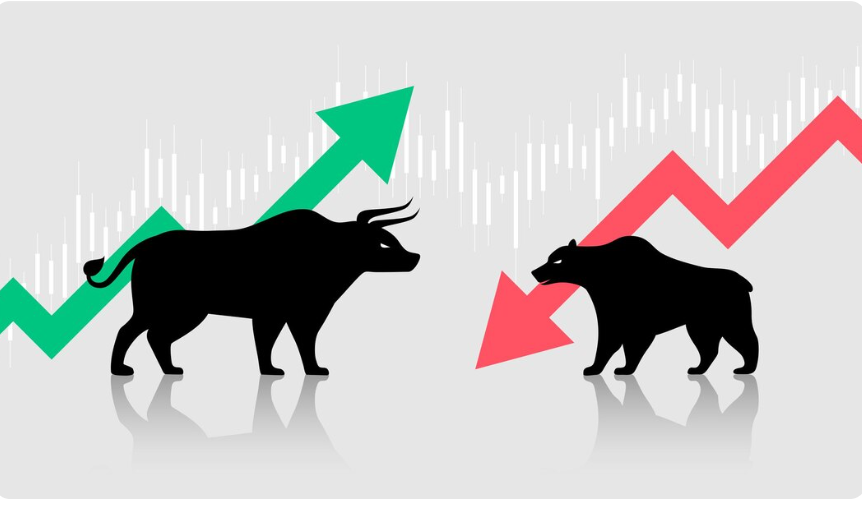
Why Is It Called Bull and Bear Market? A Guide to PSX Market Cycles
Every stock market tells a story, not just of numbers but of human emotions. The Pakistan Stock Exchange (PSX) is no different. Behind every surge of the KSE-100 Index and every sudden dip lies a mix of optimism, fear and confidence that drives investor decisions across the country.
In Pakistan’s dynamic financial landscape, these emotions shape the rhythm of the market creating phases of bullish euphoria and bearish correction. Together they form what economists call market cycles, the natural rise and fall that define every major exchange in the world.
For investors, understanding Why Is It Called Bull and Bear Market? is more than just theory, it’s the foundation of survival and success. Because in Pakistan’s stock market, long term growth doesn’t come from predicting daily swings; it comes from mastering mindset, discipline and patience through every phase of volatility.
Understanding the Two Market Cycles in Pakistan
In the Pakistan Stock Exchange (PSX), market movements are shaped by both economic fundamentals and investor psychology. A bull market reflects a phase of expansion, confidence and sustainable growth where stock prices rise, trading volumes increase and investors expect continued improvement in corporate performance.
In contrast, a bear market signals contraction and uncertainty. Prices fall sharply, risk aversion dominates and many investors move their capital toward safer assets such as gold or foreign currency.
Market analysts generally use the following benchmarks to identify these cycles:
• A 20% rise from recent lows indicates a Bull Market.
• A 20% decline from recent highs marks a Bear Market.
Beyond these technical measures, the PSX remains deeply influenced by investor emotions optimism, caution and fear, which can swiftly shift market confidence into uncertainty.
The Bull Market Phase
In recent years, the Pakistan Stock Exchange (PSX) has witnessed one of its strongest bull runs in more than a decade. After the economic turbulence of 2022, when market sentiment and valuations hit historic lows & the KSE-100 Index rebounded sharply, crossing 147,000 points in August 2025, marking an all time high.
This powerful recovery was driven by a combination of stabilizing IMF-backed reforms, a strengthening Pakistani rupee, controlled inflation, and a surge in foreign portfolio inflows that revived overall investor confidence.
Key Characteristics of a Bull Market in Pakistan
- Rising Stock Prices: The PSX-100 Index has gained nearly 70% between 2023 and 2025, reflecting strong investor momentum.
- High Corporate Earnings: Key sectors such as banking, energy and cement have reported robust profitability, driving market optimism.
- Improved Economic Indicators: Pakistan’s GDP growth has stabilized around 3.5%–4%, indicating a gradual economic recovery.
- Strong Liquidity: Lower interest rates and renewed participation from both institutional and retail investors have strengthened market liquidity.
- Increased Risk Appetite: Investors are shifting from defensive holdings toward equities, IPOs and growth-oriented sectors in pursuit of higher returns.
However, history reminds us that excessive optimism can lead to overvaluation as seen during the 2016–2017 PSX rally, when the index surged past 52,000 points before undergoing a sharp correction.
The key takeaway growth should be celebrated, but never blindly trusted. Sustainable investing depends on discipline, diversification and an understanding of long term fundamentals not emotion or hype.
The Bear Market Phase When Fear Takes Over
Just as the PSX experiences euphoric bull runs, it also faces inevitable bear markets periods when fear dominates investor sentiment. Pakistan’s stock market has witnessed several such downturns, including the 2008 global financial crisis, the 2019 fiscal tightening and the 2022 political and economic turmoil, each triggering prolonged bearish trends.
Key Signs of a Bear Market in Pakistan
· Falling Index Levels: The KSE-100 Index plunged nearly 40% during 2022’s volatility, wiping out billions in market capitalization.
· Economic Slowdown: Persistent currency depreciation, high interest rates and rising inflation severely weakened investor confidence.
· Corporate Profit Decline: Industrial sectors like cement, textile and energy saw profits shrink amid reduced demand and rising costs.
· Shift Toward Safe Havens: Investors moved capital to gold, U.S. dollar assets, and fixed income securities, seeking safety over risk.
· Emotional Trading Behavior: Fear and panic driven selloffs became widespread as confidence in the market evaporated.
Yet, history shows that every PSX bear phase eventually gives rise to a stronger recovery. The investors who remain patient, diversified, and disciplined often emerge far ahead once the cycle turns.
How a Bull Market Turns into a Bear (and Back Again)
The Pakistan Stock Exchange (PSX) doesn’t move randomly, its ups and downs reflect the rhythm of Pakistan’s broader economic and political landscape. Every bull market eventually cools down and every bear phase sets the foundation for recovery.
Times of rapid economic growth often bring policy tightening, rising interest rates or political instability, which slow momentum and cool investor enthusiasm. Conversely, downturns tend to invite IMF support, macroeconomic reforms and fresh foreign inflows, fueling the start of the next bullish rally.
Key Triggers Behind PSX Market Transitions
1. Economic Fundamentals: Declines in GDP growth or corporate profitability typically spark market corrections.
2. Monetary Policy Shifts: When the State Bank of Pakistan (SBP) raises interest rates, liquidity tightens and reducing equity demand.
3. Political Uncertainty: Elections, coalition changes or policy reversals can rapidly shake investor confidence.
4. External Shocks: Oil price volatility, global recessions or geopolitical conflicts directly impact Pakistan’s export driven sectors.
5. Valuation Pressure: When stock prices trade well above intrinsic value, even minor negative news can trigger profit taking or sell offs.
Recognizing these early signals helps investors anticipate market shifts rather than react emotionally. Understanding the transition between bull and bear markets allows for smarter positioning and long term stability in the face of short term volatility.
Investor Psychology — The Driving Force Behind PSX Market Movements
In the Pakistan Stock Exchange (PSX), investor psychology often shapes market direction more powerfully than economic data or company fundamentals. The emotions of optimism and fear drive buying and selling patterns, creating distinct phases of boom and correction.
During bull markets, optimism spreads rapidly. Social media buzz, IPO excitement, and the “fear of missing out (FOMO)” push investors toward high risk stocks, often without evaluating their intrinsic value. But when sentiment turns negative, fear triggers panic selling, even in fundamentally strong companies.
The most successful PSX investors typically institutional investors and long term participants remain disciplined and patient through both extremes. They rely on rational analysis, sound risk management and strategic diversification instead of emotional decisions.
Core Habits of Emotionally Intelligent Investors
· Rational Analysis Over Rumors: They trust data, not market gossip.
· Long Term Focus: They look beyond short term volatility and chase sustainable growth.
· Valuation Discipline: They buy quality stocks at fair prices and diversify portfolios to reduce risk.
Emotions may move the PSX in the short run, but in the long run, discipline and patience define lasting success.
Lessons from Pakistan’s Past Market Cycles
The history of the Pakistan Stock Exchange (PSX) proves that every crash, correction and recovery leaves investors with valuable lessons. Over the years, market cycles have reflected the country’s economic, political and global shifts teaching one universal truth: discipline always beats emotion.
2008 Financial Crisis
The PSX suffered a historic crash, losing over 50% of its value as the global financial crisis rippled across economies. Yet, within three years, the market rebounded, rewarding investors who held their positions patiently.
2013–2017 Bull Run
Fueled by CPEC optimism, foreign investment and stable government policies, this period marked one of the longest and strongest rallies in PSX history taking the KSE-100 Index beyond 52,000 points before a correction.
2019–2022 Bear Phase
Political instability, record inflation and currency depreciation eroded investor confidence. The market struggled under tight monetary policies and economic uncertainty, pushing investors toward safer assets.
2023–2025 Bull Resurgence
The tide turned again with IMF-backed reforms, exchange rate stability and strong corporate earnings. These factors reignited foreign investor trust and brought renewed momentum to the PSX, driving it to record highs in 2025.
Each of these cycles highlights a powerful insight, those who stay consistent, patient and analytical in Pakistan’s market eventually outperform those driven by fear.
How Smart Pakistani Investors Navigate Market Cycles
In the Pakistan Stock Exchange (PSX), successful investors understand that bull and bear markets are part of a continuous cycle and survival depends on strategy not emotion. The smartest Pakistani investors adapt their approach according to market conditions, focusing on fundamentals, patience and timing.
During a Bull Market
When optimism drives prices higher, wise investors stay grounded:
· Focus on Value, Not Speculation: Invest in companies with strong fundamentals and sustainable earnings rather than chasing hype stocks.
· Rebalance Your Portfolio: Review and adjust holdings to maintain proper diversification as prices rise.
· Lock Profits Gradually: Take profits in stages instead of holding unrealistically high targets.
· Monitor Valuation Metrics: Keep an eye on P/E ratios, dividend yields and earnings growth to avoid overvaluation.
During a Bear Market
When fear dominates, opportunities often hide beneath the panic:
· Avoid Panic Selling: Market downturns are temporary, emotional exits often lead to losses.
· Accumulate Quality Stocks: Buy fundamentally strong companies trading at discounted prices.
· Maintain Liquidity: Keep cash available to seize opportunities when valuations drop.
· Think Long Term: Historically, the PSX always recovers, rewarding those who remain patient and consistent.
The smartest investors in Pakistan don’t try to time the market, they prepare for it. Whether bullish or bearish, they let strategy and discipline lead not emotion.
Final Thoughts: Riding the PSX Cycle with Discipline
The Pakistan Stock Exchange (PSX) has taught one timeless lesson, no bull or bear market lasts forever. Every phase, whether defined by confidence or fear, rewards investors who remain patient, informed and disciplined.
In Pakistan’s market, a bull run rewards preparation not speculation while a bear phase tests patience not panic. The real secret to wealth creation lies not in timing the market, but in spending time in the market with consistency and conviction.
For Pakistani investors, mastering this rhythm means learning to stay rational during euphoria and calm during chaos. Because history proves one simple truth the PSX always rises again for those who trust fundamentals, think long-term, and let discipline lead their decisions.
We closely track Pakistan’s financial and energy sector developments to help investors make informed decisions. Stay connected with Azee for expert insights on the Pakistan Stock Exchange (PSX), economic reforms and investment opportunities. The content provided in this article is for informational and educational purposes only and does not constitute investment advice from Azee Securities. Readers are encouraged to seek independent professional guidance before making any financial decisions.
 (1).png)






























Add a comment